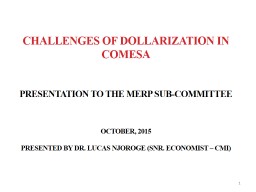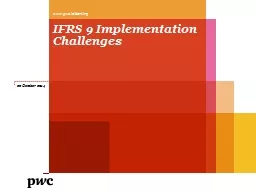PPT-CHALLENGES OF DOLLARIZATION in
Author : mila-milly | Published Date : 2023-10-30
comesa Presentation to the MerP subcommittee October 2015 presented by dr lucas Njoroge snr Economist cmi 1 Presentation Outline Introduction Why Dollarization
Presentation Embed Code
Download Presentation
Download Presentation The PPT/PDF document "CHALLENGES OF DOLLARIZATION in" is the property of its rightful owner. Permission is granted to download and print the materials on this website for personal, non-commercial use only, and to display it on your personal computer provided you do not modify the materials and that you retain all copyright notices contained in the materials. By downloading content from our website, you accept the terms of this agreement.
CHALLENGES OF DOLLARIZATION in: Transcript
comesa Presentation to the MerP subcommittee October 2015 presented by dr lucas Njoroge snr Economist cmi 1 Presentation Outline Introduction Why Dollarization Country Experiences. PRESENTED ON 16. TH. MAY, 2014. BY; ELIZABETH MUTEMI. . MSc. . NURSING (PEADS). . . OPTIMIZING MEDICINE USE TO IMPROVE PATIENT OUTCOMES. . OUTLINE.. Guiding principles.. Expected outcomes in medicine use.. Rahmat Budiman. University of Dundee (United Kingdom). r.budiman@dundee.ac.uk. Barcelona (Spain), 7th, 8th and 9th of July, 2014. : rahmat.budiman71. I will be online during the conference for a . s. www.pwc.ie/banking. 22 October 2014. Agenda. Background to IFRS 9: The project and timetable for implementation. Classification and measurement. Overview of Expected credit losses in IFRS . 9. Implementation . Dr U. Mazarura, Department of Crop Science, University of Zimbabwe. Alternatives. Tobacco. metam sodium. 1.3.D and chloropicrin. 1.3.D and MITC. Burning. Float tray system. Grain. Phosphine (aluminum phosphide/magnesium phosphide). Transporting Radioactive Material. C. T. M. A. 2. 0. 1. 5. Presented by. Salina Savage. President/Member. About Savage Logistics . Formation 2007. Owners: Salina Savage & Barbara Stone. Women Owned, SBA 8(a) Certified. Dr. Paul Rockett . Casualty Actuaries in Europe, 31 May . 2013. 31 May 2013. Page . 1. Agenda. Introduction. Validation tools. Validating catastrophe models. The bigger picture. Summary. Challenges in Validating Catastrophe Models. Integrated Energy. District Heating and Cooling – Optimized Comfort. Brian Boyd. Pacific Northwest National Laboratory. August 12, 2015. 2. Introduction. Background. 3. 4. Cooling Towers – Two Different Designs. vmc. Virginia Mennonite conference Pastoral consultation. Facilitated by . david brubaker. November 11, 2015. 5 principles of change and conflict in congregations. The “identified issue” is (almost) never the “real issue.”. . C. Arson, Georgia Institute of Technology. G. . Buscarnera. , Northwestern University. Outline. Introduction. – 2014 Geotechnical Education Workshop in Cambridge, UK. Pre-requisites . to undergraduate geotechnical engineering. What is DESE?. If your science and engineering is not data enabled…. …you’re not doing it right.. http://. drewconway.com. /. zia. /2013/3/26/the-data-science-. venn. -diagram. Big Data in Agriculture (Today). Arindam Das Sarkar. Table of Contents. Introduction. Key Observations. Market Drivers. Market Scenario. Market Challenges. The Way Forward. Are We Secure ???. . Introduction. India . is now an emerging hub for global economical, trade, and tourism activities. . Disclaimer: The views expressed in this document are those of the author, and do not necessarily reflect the views and policies of the Asian Development Bank (ADB), its Board of Directors, or the governments they represent. ADB does not guarantee the accuracy of the data included in this document, and accept no responsibility for any consequence of their use. By making any designation or reference to a particular territory or geographical area, or by using the term “country” in this document, ADB does not intend to make any judgments as to the legal or other status of any territory or area. . Top 10 Public Health Achievements of the 20. th. Century. Routine use of . _____________. Improvements in . _____________ safety. Safer . _____________. Control of . _____________ diseases. _____________ in . Internet-Draft (IRTF-T2TRG). Henrique . Pötter. Draft origins. Based in a draft from 2011. Security Considerations in the IP-based Internet of Things. Draft origins. Based in a draft from 2011. Security Considerations in the IP-based Internet of Things.
Download Document
Here is the link to download the presentation.
"CHALLENGES OF DOLLARIZATION in"The content belongs to its owner. You may download and print it for personal use, without modification, and keep all copyright notices. By downloading, you agree to these terms.
Related Documents














